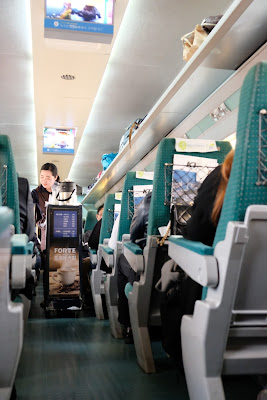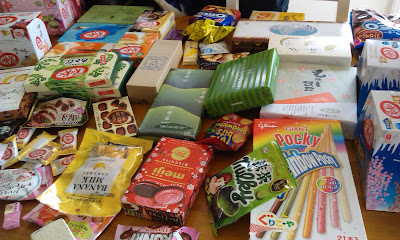Korea 2016 Day 3
Train to Busan
Gamcheon Village
BIFF Square
Hotteok
"Live" eel and catfish
Train to Busan
Seoul Station has a layout not dissimilar to an airport, making for easy navigation in searching for ticket checks and train boarding. Having purchased tickets online, these were retained at the Korail ticket booths, which makes for saved time and less stress during busier travelling seasons. Plenty of eateries line the waiting areas to appease the tourist-dense crowds suspected to gather in such places, offering sit-down restaurants, fast food franchises, and quick takeaway meals like
dosirak lunchboxes to take onboard the train.
 |
| The train to Busan, without zombies |
Boarding is mainly unsupervised and fairly unceremonious, with ample signage contributing to a simple boarding process. As always, ask if in doubt, but following the signs and ticket information is a self-explanatory process. The trains are reminiscent of aeroplanes in terms of the seats, and overhead screens show basic information such as time to destination interspersed with advertisements. The journey from Seoul to Busan takes approximately 2.5 hours, and in my experience the estimated arrival times indicated on the screens are accurate.
 |
| Smoggy train views throughout Korea. I don't doubt that there are better days. |
Gamcheon Village
Gamcheon, also known as the Machu Picchu of Busan, is a colourful village located at the top of a mountain near central Busan, and is accessible by bus from the surrounding towns. Previously a shanty town, it was redeveloped to draw in tourists, soon becoming a famous local attraction. Structured in what is described as "staircase-fashion", the layers of colourful houses brings to mind South America more than the centre of an Asian metropolitan city.
 |
| Gamcheon from the rooftops |
 |
| Gamcheon from a different rooftop |
Though residents still remain, many houses have also been converted into tourist businesses. Along the mazes of the main roads of Gamcheon, one can encounter any number of giftshops, cafes, exhibitions, and the ever-present street food (though the offerings are fairly similar to those found outside the village). Certainly, its selling point is its stunning views and undeniable Instagramability, as one might say. With plenty of sights and a relaxed atmosphere, Gamcheon may not be necessarily dense in entertainment but it is a good place to spend a half-day immersed in a bubble of colour within a busy city.
 |
| The art around Gamcheon |
 |
| A cat in Gamcheon |
 |
| Gamcheon village |
BIFF Square
Busan International Film Festival Square developed into a tourist attraction after renovations were made to a pair of cinemas in preparation for the first Busan Film Festival. Offering plenty of shopping, both brand names and neighbourhood boutiques, the streets are also lined with masses of street food carts, making it an easy location to kill a lot of time.
 |
| BIFF square |
Hotteok
Arguably the most famous street food in Busan,
hotteok is a chewy pancake filled with nuts or seeds and sugar or honey. Ranging from
₩1,000-2,000, these are cooked empty, split open, and filled to order, as compared to the
hotteok more commonly found in Seoul, which is stuffed prior to frying.
 |
| A hotteok stand in BIFF |
Like most Korean street food, it is unlikely that the pancake itself is fried to order, but filling it on the spot retains the texture of the seeds. While I would love to experience a freshly cooked
hotteok, it's definitely a food item that must be eaten when in Busan, either as a dessert, a snack, or having successive
hotteok from consecutive stands as a full meal (which I have come close to doing, if not interrupted by the cup of
ddeokbokki from BIFF).
Live Eel
With an ostentatiously ominous name, this must-try dish is served in many places throughout Korea, commonly at the dozens of restaurants in the neighbourhood surrounding the
Jagalchi fish market. Live eels are slaughtered and prepared in the restaurant, and served immediately such that the muscle continues to twitch. Due to the high foot traffic of the more famous establishments, this guarantees that the freshest seafood ends up right on the grill.
 |
| A common sight of fish tanks outside eateries |
There are two common styles of preparation. Fresh meat can be grilled directly as would happen in a typical Korean barbecue; alternatively cooked in a foil package on the grill with vegetables and a sweet, spicy, savoury marinade of
gochujang pepper paste. Ideally, once the meat has been consumed, steamed rice is mixed in with the leftover sauce and eaten as a sort of fried rice. Either dish is accompanied by a selection of wrapping vegetables and the ever-present side dishes.
 |
| Barbecued |
 |
| Enjoyed just like Korean barbecue |
 |
| Seasoned |
Though typically any restaurant with displays of eel tanks in the Jagalchi region will serve either of these dishes, the restaurant we ate at ("제일꼼장어", address South Korea, Busan, Jung-gu, Nampo-dong, Jagalchihaean-ro, 제일꼼장어) is located on a corner right outside the fish market, whose servers could speak basic English which made ordering easier. We ordered barbecued eel and spicy catfish, in order to try a variety of seafood. Amongst my family, this was one of the best meals we had in Korea, and we would return with no hesitation if we were in the area.
















Comments
Post a Comment